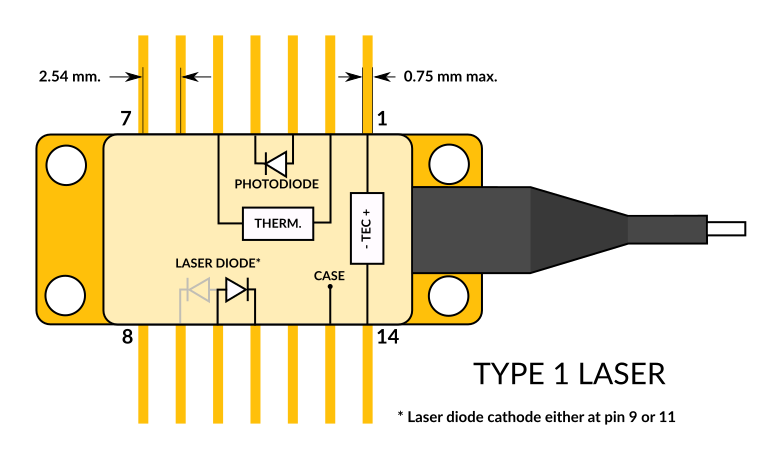Laser connections
The CTL101-1 / CTL101-2 is compatible with Type 1 / Type 2 butterfly laser diodes. Note that it is only compatible with floating diodes.


Quickstart

- Make sure the laser current switch (CURR) and the TEC current switch (TEMP) are OFF. Set the TPROT switch ON.
- Set the VCC jumper to 5 V.
- Plug the laser diode on the ZIF socket. Make sure there is a good thermal connection between the laser case and the base plate. Use thermal paste if necessary.
- Power the board with 5 V between VCC and GND pins (set the VCC jumper accordingly). The power supply must be able to supply at least 2 A (2.5 A for the 800 mA version).
- Set the current to 0 mA by turning the laser current trimmer (CURR) counter-clockwise.
- Turn the POWER switch ON.
- Adjust the temperature trimmer to get 2.5 V on the TSET pin.
- Turn ON the TEC current switch.
- Check that the voltage between the TSET and TACT pins converges towards zero. The laser temperature is now stabilized at 25 °C.
- Turn ON the laser current switch.
- Turn the laser current trimmer (CURR) clockwise to reach the desired laser current.
Enable switch
- CURR: Turn ON to enable laser current.
- TEMP: Turn ON to enable TEC current.
- TPROT: When this switch is ON, the laser current is automatically disabled in case of a TEC fault condition (see FAULT LED).
LEDs
- LASER: The brightness of this LED is proportional to the laser power measured on the monitoring photodiode.
- FAULT: Indicates a TEC fault condition, i.e. when the TEC driver is no longer capable of cooling the laser at the desired temperature.
Terminal block connections
VCC: Connect this pin to a 5 V or 6 V power supply. Using a 6 V supply provides 1 V of extra compliance voltage. The VCC jumper must be set according to the chosen power supply.
TACT: Temperature monitoring pin. The thermistor value is given by
Rth = 10 kΩ * (10 V - VTACT) / (5 V + VTACT).
The pin output impedance is 1 kΩ. The graph below was obtained for a typical 10k resistor (see Python code).
CTL101 Temperature vs V TACT TSET: Temperature setpoint monitoring pin.
VTSET = VTREF + (1 / 10) * VTMOD
where VTREF is the voltage generated by the TEMP trimming potentiometer. The voltage VTREF can be tuned between 0 and 4 V and can be measured at test point TP2. VTMOD is the voltage applied at the TMOD pin. The PID controller tries to make the voltage VTACT equal to the setpoint VTSET. The pin output impedance is 1 kΩ.ITEC: TEC current monitoring pin. The TEC current ITEC is given by
ITEC = 1 A/V * (VITEC - 2.5 V)
where VITEC is the voltage measured at the ITEC pin. The pin output impedance is 1 kΩ.TMOD: Temperature modulation pin. Apply a voltage between -3 V and +3 V at this pin to control the temperature setpoint externally (see description of the TSET pin).
ILAS: Laser current monitoring pin. The laser current ILAS is given by
ILAS = G * VILAS, where VILAS is the voltage measured at the ILAS pin and G is 50 mA/V for the 100 and 200 mA version, 100 mA/V for the 400 mA version and 200 mA/V for the 600 and 800 mA versions. The pin output impedance is 1 kΩ.EN: Laser Enable pin. When the CURR switch is turned OFF, the laser current can be enabled by applying a voltage between 2.2 V and 5.5 V on the EN pin.
PD: Output of the transimpedance amplifier that monitors the laser power. This output has 3.9 V/mA gain, a bandwidth from DC to 20 MHz, and is terminated with a 50 Ω resistor. The actual laser power depends on the photodiode integrated in the laser and should be calibrated by the user. The LASER LED brightness is proportional to VPD.
Modulation inputs
The CTL101 has two current modulation inputs available on SMA connectors:
DC modulation input for modulation between DC and 10 MHz. Modulation range is ±1 V. A jumper allows to choose between 3 modulation gains. Input impedance is 50 Ω.
AC modulation input for modulation above 1 MHz. Modulation gain is 20 mA/V. Input impedance is 50 Ω.

